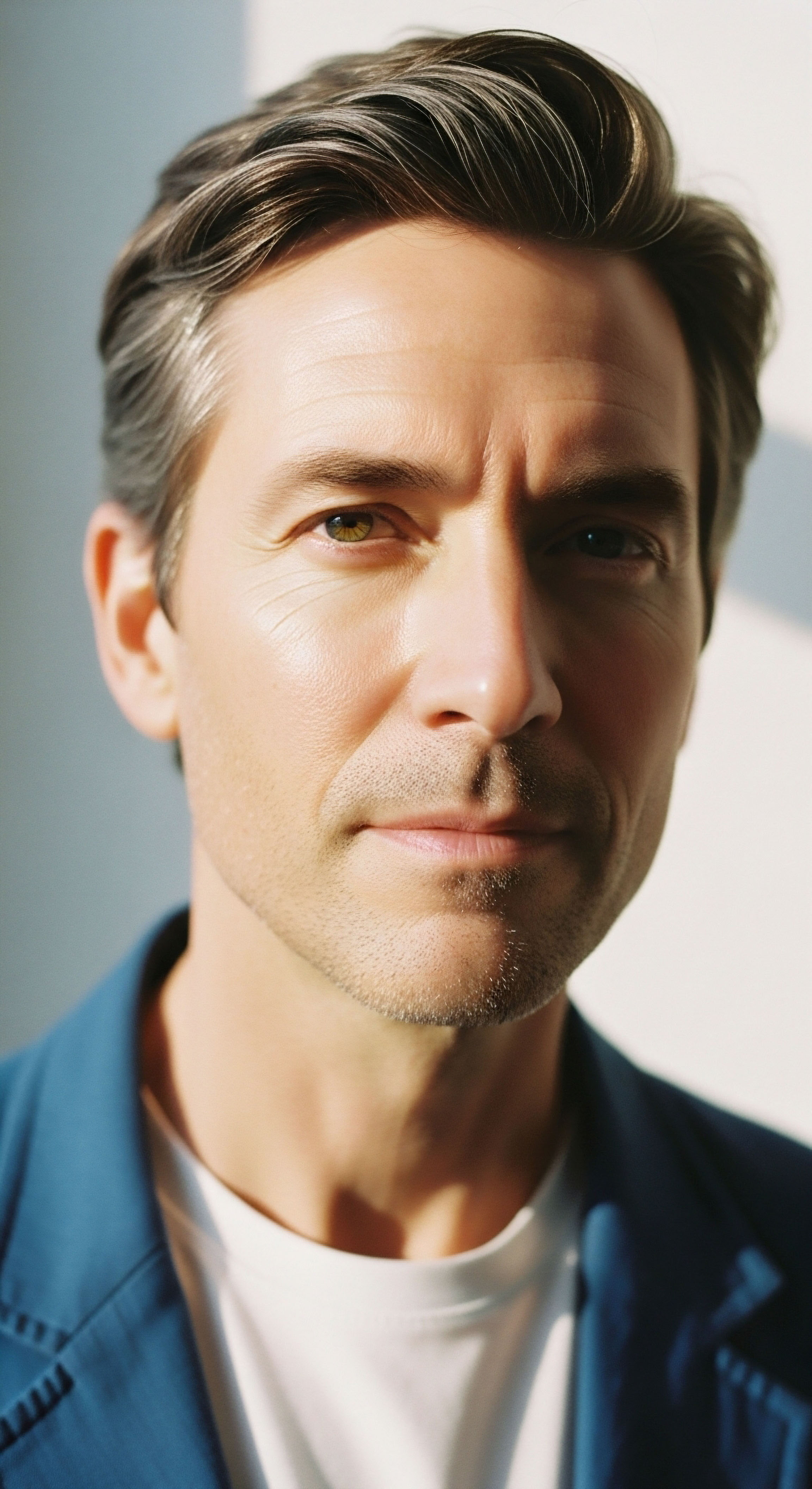

Fundamentals
The decision to begin a journey of hormonal optimization is deeply personal, often born from a quiet awareness that your body’s vitality is not what it once was. You may feel a pervasive sense of fatigue, a subtle decline in physical strength, or a mental fog that clouds your focus.
These experiences are valid, and they point toward underlying shifts in your intricate biological systems. When considering Testosterone Replacement Therapy (TRT), the concern about hair loss is both common and understandable. It touches upon our identity and how we present ourselves to the world. The question of whether this outcome is inevitable, particularly if you carry a genetic predisposition to hair thinning, deserves a clear, scientifically grounded exploration.
Your body is a complex, interconnected network. Hormones act as messengers, carrying signals that regulate everything from energy production to mood and, yes, hair growth. Testosterone itself is not the primary agent in hair loss. Instead, a small percentage of it is converted into a more potent androgen called dihydrotestosterone, or DHT.
This conversion is a natural biochemical process. For individuals with a genetic sensitivity to androgenetic alopecia (male or female pattern baldness), the hair follicles on the scalp have a heightened reactivity to DHT. This hormone can bind to receptors in these follicles, initiating a process of miniaturization.
The growth phase of the hair cycle shortens, and with each new cycle, the hair shaft becomes finer and shorter, until it may eventually cease to grow altogether. This is not a failure of your system; it is a genetically programmed response.
Understanding this mechanism is the first step toward empowerment. It reframes the issue from a simple cause-and-effect relationship to one of predisposition and influence. While you cannot alter your genetic blueprint, you possess a remarkable degree of control over the environment in which your genes operate.
Lifestyle and diet are not merely supportive players; they are powerful modulators of your internal biochemistry. They can influence hormonal balance, inflammation, and nutrient availability, all of which are critical factors in the health of your hair follicles. The journey of hormonal optimization, therefore, includes a conscious and proactive approach to supporting your body’s resilience from within.


Intermediate
Embarking on a protocol of hormonal optimization invites a deeper understanding of the body’s intricate feedback loops. When you introduce exogenous testosterone, you are intentionally recalibrating a complex system. The concern over hair loss, in this context, moves beyond a simple fear and becomes a specific, addressable variable within your personalized wellness protocol.
The central question is no longer “if” hair loss will occur, but “how” you can architect your lifestyle and diet to create a biological environment that minimizes this risk, even with a known genetic predisposition.

The Central Role of DHT and Follicular Sensitivity
Testosterone’s conversion to dihydrotestosterone (DHT) is mediated by the enzyme 5-alpha reductase. While TRT aims to restore testosterone to optimal physiological levels, this can concurrently increase the substrate available for conversion to DHT. For an individual with a genetic predisposition to androgenetic alopecia, the hair follicles on the scalp possess a high density of androgen receptors that are exceptionally sensitive to DHT’s signaling.
This sensitivity is the critical factor. The DHT molecule, when bound to these receptors, triggers a cascade of events within the follicle’s cells that shortens the anagen (growth) phase and extends the telogen (resting) phase of the hair growth cycle. Over time, this leads to the progressive miniaturization of the follicle and the visible thinning of hair.
A nutrient-dense diet provides the essential building blocks for robust hair structure and growth.
It is a misconception to view this process as universally applicable to everyone on TRT. The degree of hair loss, if any, is a direct reflection of an individual’s unique genetic inheritance and the specific sensitivity of their hair follicles.
This is why some individuals may notice significant changes, while others experience none at all, despite similar testosterone and DHT levels. Regular monitoring of hormone levels, including testosterone, DHT, and estrogen, is a cornerstone of a well-managed TRT protocol, allowing for precise adjustments to mitigate potential side effects.

Can Diet Influence DHT and Follicular Health?
Your dietary choices can exert a significant influence on the factors that contribute to hair health. While no diet can single-handedly eliminate a strong genetic predisposition, a strategic nutritional approach can support the body’s systems and potentially mitigate the extent of hair thinning. The focus is on providing essential nutrients for hair growth, managing inflammation, and supporting overall hormonal balance.
A diet rich in specific micronutrients is fundamental. Biotin, a B-vitamin, is essential for the production of keratin, the primary protein that constitutes hair. Zinc plays a vital role in hair tissue growth and repair, and its deficiency is often linked to hair loss.
Iron is another critical mineral, as low levels of ferritin (the body’s iron storage protein) are associated with increased hair shedding. Incorporating foods rich in these nutrients, such as eggs, nuts, seeds, leafy greens, and lean proteins, provides the raw materials for healthy hair follicle function.
Furthermore, some natural compounds found in food may have a modest effect on DHT activity. For instance, lycopene (found in tomatoes) and green tea catechins are antioxidants that have been studied for their potential to modulate 5-alpha reductase activity.

Lifestyle Interventions for a Resilient System
Lifestyle factors are equally important in creating a supportive internal environment. Chronic stress is a significant contributor to hair shedding, a condition known as telogen effluvium. High levels of cortisol, the body’s primary stress hormone, can disrupt the normal hair growth cycle.
Implementing stress management techniques such as meditation, deep breathing exercises, or regular physical activity can help regulate cortisol levels and promote a healthier hormonal balance. Exercise, in particular, improves blood circulation, ensuring that the scalp and hair follicles receive an adequate supply of oxygen and nutrients.
Gentle hair care practices also play a role. Avoiding harsh chemical treatments, excessive heat styling, and tight hairstyles that place mechanical stress on the hair shaft can help preserve the integrity of the hair you have. These lifestyle adjustments, when combined with a nutrient-dense diet, form a comprehensive strategy to support your body’s systems while undergoing hormonal optimization.
They empower you to take proactive steps, transforming your approach from one of passive concern to one of active, informed self-care.


Academic
A sophisticated analysis of mitigating hair loss risk during Testosterone Replacement Therapy requires moving beyond generalized advice and into the specific biochemical and physiological mechanisms at play. For the individual with a confirmed genetic predisposition to androgenetic alopecia, the introduction of exogenous testosterone presents a direct challenge to the delicate homeostasis of the hair follicle.
The core of this challenge lies in the interplay between enzymatic conversion, receptor sensitivity, and the downstream signaling cascades that govern follicular cycling. A truly effective mitigation strategy, therefore, must be multi-pronged, addressing not just the hormonal axis, but also the inflammatory and nutritional microenvironment of the scalp.

The 5-Alpha Reductase Enzyme System
The conversion of testosterone to dihydrotestosterone (DHT) is catalyzed by the 5-alpha reductase enzyme, which exists in two primary isoforms ∞ type 1 and type 2. Type 2 is predominantly found in the outer root sheath of the hair follicle and is the primary catalyst for the production of DHT that drives androgenetic alopecia.
Genetic variations can influence the expression and activity of this enzyme, leading to differing rates of DHT production among individuals. While systemic DHT levels are a factor, it is the localized concentration and the hyper-responsiveness of the follicular androgen receptors that are of paramount importance.
Pharmacological interventions such as finasteride and dutasteride are potent inhibitors of 5-alpha reductase, with dutasteride inhibiting both type 1 and type 2 isoforms. These medications can be highly effective in reducing scalp DHT levels and are often used in conjunction with TRT to manage hair loss.
However, a lifestyle- and diet-based approach seeks to modulate this pathway through non-pharmacological means. Certain dietary components have been investigated for their potential to influence 5-alpha reductase activity. For example, the fatty acids in pumpkin seed oil and the polyphenols in green tea have been shown in some studies to exhibit mild inhibitory effects on the enzyme. While these effects are not as potent as pharmaceutical interventions, they may contribute to a cumulative risk reduction strategy.

What Is the Role of Inflammation and Oxidative Stress?
The pathophysiology of androgenetic alopecia is increasingly understood to involve micro-inflammation and oxidative stress within the hair follicle. DHT, upon binding to its receptor, can trigger the production of pro-inflammatory cytokines. This low-grade inflammatory state can further damage the follicle and disrupt its function.
A diet high in processed foods, refined sugars, and unhealthy fats can exacerbate systemic inflammation, creating an environment that is less conducive to healthy hair growth. Conversely, a diet rich in anti-inflammatory compounds can help to counteract this effect.
Omega-3 fatty acids, found in fatty fish like salmon and mackerel, are potent anti-inflammatory agents. Antioxidants, such as vitamin C, vitamin E, and selenium, help to neutralize reactive oxygen species that can damage cellular structures, including those within the hair follicle.
By adopting an anti-inflammatory dietary pattern, one can create a more favorable biological terrain, potentially reducing the inflammatory component of DHT-mediated hair loss. This approach shifts the focus from merely blocking a hormone to improving the overall resilience and health of the target tissue.
| Nutrient | Biochemical Role | Dietary Sources |
|---|---|---|
| Biotin (Vitamin B7) | Essential for keratin production, the primary protein in hair. | Eggs, almonds, salmon, avocados. |
| Zinc | Plays a crucial role in hair tissue growth and repair. | Oysters, beef, pumpkin seeds, lentils. |
| Iron | Low ferritin levels are linked to increased hair shedding. | Red meat, spinach, lentils, fortified cereals. |
| Vitamin D | May help to activate dormant hair follicles. | Fatty fish, fortified milk, sunlight exposure. |

Can Nutrient Signaling Pathways Influence Hair Growth?
Recent research has begun to explore the role of nutrient-sensing pathways, such as mTOR and AMPK, in regulating the hair growth cycle. These pathways are influenced by dietary factors, including protein intake and caloric balance.
While this area of research is still nascent, it suggests that the timing and composition of meals could, in theory, influence the signaling environment of the hair follicle. For example, adequate protein intake is necessary to provide the amino acid building blocks for keratin synthesis. Cysteine, in particular, is a key component of keratin and is found in high-protein foods.
The interplay between hormonal signals, inflammatory status, and nutrient availability creates a complex regulatory network that determines the fate of the hair follicle. A comprehensive mitigation strategy for an individual on TRT with a genetic predisposition to hair loss would therefore involve:
- Monitoring and optimizing hormone levels through a carefully managed TRT protocol.
- Implementing an anti-inflammatory diet rich in omega-3 fatty acids and antioxidants.
- Ensuring adequate intake of key micronutrients for hair health, such as biotin, zinc, and iron.
- Managing stress and cortisol levels through lifestyle interventions.
This systems-biology approach acknowledges that while genetics may load the gun, it is the cumulative effect of diet and lifestyle that can influence the trigger. It is a proactive, evidence-based strategy that empowers the individual to take a significant role in managing their health outcomes.
| Factor | Mechanism of Action | Recommended Practices |
|---|---|---|
| Stress Management | Reduces cortisol levels, which can disrupt the hair growth cycle. | Meditation, yoga, regular exercise. |
| Physical Activity | Improves blood flow to the scalp, delivering oxygen and nutrients. | At least 150 minutes of moderate-intensity exercise per week. |
| Scalp Care | Minimizes physical stress and inflammation on the hair follicles. | Use of gentle, sulfate-free shampoos; avoiding excessive heat. |

References
- Grymowicz, Monika, et al. “Hormonal Effects on Hair Follicles.” International Journal of Molecular Sciences, vol. 21, no. 15, 2020, p. 5342.
- Almohanna, Hind M. et al. “The Role of Vitamins and Minerals in Hair Loss ∞ A Review.” Dermatology and Therapy, vol. 9, no. 1, 2019, pp. 51-70.
- Zito, Patrick M. and Bopanna B. Codol. “Finasteride.” StatPearls, StatPearls Publishing, 2023.
- Adil, Areej, and Marshall Godwin. “The Effectiveness of Treatments for Androgenetic Alopecia ∞ A Systematic Review and Meta-Analysis.” Journal of the American Academy of Dermatology, vol. 77, no. 1, 2017, pp. 136-141.e5.
- Urysiak-Czubatka, Iwona, et al. “Assessment of the Usefulness of Trichoscopy in the Diagnostics of Androgenetic Alopecia.” Journal of Dermatological Science, vol. 76, no. 2, 2014, pp. 104-10.

Reflection
You have now explored the intricate biological landscape that connects hormonal optimization with the health of your hair. This knowledge is more than a collection of facts; it is a toolkit for self-advocacy and proactive management of your health journey.
The information presented here illuminates the pathways and mechanisms at play, transforming abstract concerns into tangible, addressable variables. The path forward is one of conscious choices, where you partner with your body’s own systems to foster an environment of resilience and vitality.
This understanding is the foundational step, empowering you to engage in informed dialogue with your healthcare provider and to build a personalized protocol that aligns with your unique biology and your ultimate wellness goals. The power to influence your health outcomes resides within this informed, proactive stance.

Glossary

hormonal optimization

genetic predisposition

hair loss

dihydrotestosterone

dht

androgenetic alopecia

lifestyle and diet

5-alpha reductase

trt

hair growth cycle

hair health

biotin

zinc




